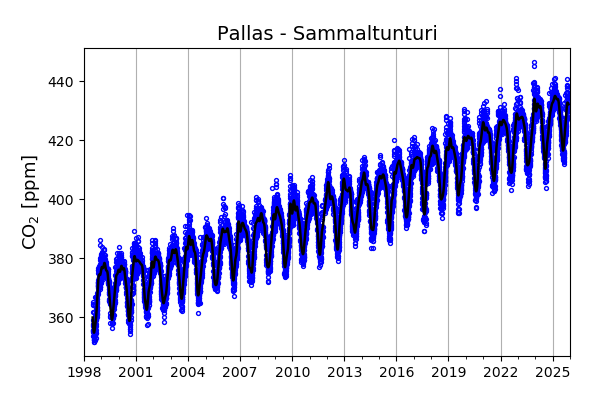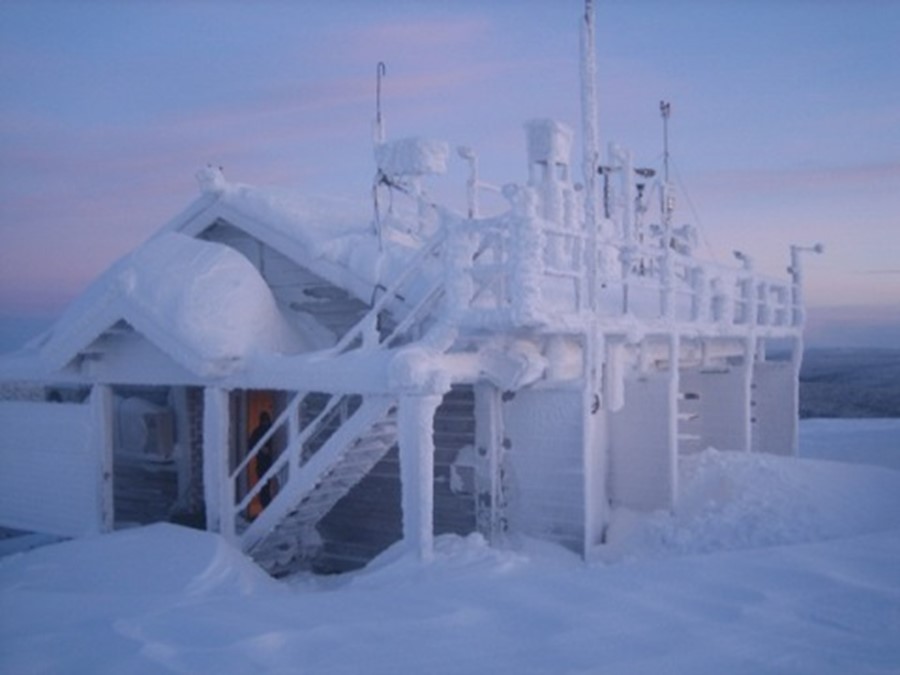Greenhouse Gases research
The Greenhouse Gases research group studies greenhouse gas concentrations and their exchange between the atmosphere and different ecosystems experimentally and theoretically. Greenhouse Gases group has two focus research areas: • Concentration measurements • Flux measurements

Accurate ambient air concentration measurements are the basis in following trends and in estimation of regional sources and sinks. These are done by atmospheric transport and biogeochemical models which use also remote sensing data. The research is based on internationally well-calibrated atmospheric concentration and ecosystem net gas flux measurements carried out in multiple locations both in Finland and abroad. The main research station is Pallas-Sodankylä observatory which is one of the main WMO Global Atmosphere Watch sites on high latitudes.
Micrometeorological flux measurements are conducted to observe carbon dioxide (CO₂) sinks and sources of forests, wetlands and fields and methane (CH₄) emissions from wetlands and landfills.
Concentration and flux measurement stations of the Greenhouse Gases group
Concentration measurements

CO₂, CH₄, and nitrous oxide (N₂O) are the most important greenhouse gases, whose atmospheric concentrations are increasing due to human activities. Accurate internationally calibrated concentration measurements are needed for monitoring their trends. Observations from global monitoring network, together with atmospheric transport models, are used to estimate large-scale sources and sinks. Global Atmospheric Watch programme of the World Meteorological Organization coordinates the global network and primary calibration scales. Integrated Carbon Observing System (ICOS) infrastructure coordinates the European regional network. ICOS and national well-calibrated atmospheric concentration sites cover Finland from the southern archipelago to arctic Lapland. Instrumentations in the ecosystem flux sites are extended to support various ecological research.
Finnish Meteorological Institute operates Pallas-Sodankylä GAW-station. In Pallas node, the main greenhouse gases are measured continuously and weekly air samples are sent to NOAA in Boulder, USA for analyses as part of the Cooperative air sampling network of the NOAA/ESRL and to ICOS Central Analytical Laboratory. The regional ICOS network for accurate carbon dioxide and methane observations in Finland have measurements at Pallas, Utö island on the Baltic Sea, Puijo-tower in Kuopio (University of Eastern Finland) and Hyytiälä (University of Helsinki). In addition, FMI conducts monitoring at Sodankylä node of the GAW station and at FMI premises at Kumpula, Helsinki.
FMI measures greenhouse gases at Base Marambio (Antarctica) in co-operation with Argentina Meteorological Service and at Tiksi on the coast of the Laptev Sea and at Cape Baranova on Bolshevik island, the Arctic Ocean (measurements suspended) in co-operation with Russian Hydrometeorological Service and Arctic and Antarctic Research Institute.
More concentration graphs here
Flux measurements

The greenhouse gas exchange between atmosphere and biosphere varies markedly depending on the ecosystem and prevailing environmental conditions. CO₂ is fixed to the ecosystem by the plant photosynthesis. On the other hand, CO₂ is released to atmosphere by plant respiration and soil microbes. During the Holocene, the forests and wetlands of boreal zone have accumulated great carbon reservoirs in the peat and mineral soils. CH₄ is formed when organic matter decomposes in anoxic condition. The natural CH₄ formation is greatest in humid ecosystems (wetlands, lakes). Human activities release significant CH₄ emissions from landfills and ruminants. N₂O emissions are rather small from natural ecosystems but the agricultural soils are an important source for N₂O due to the use of nitrogen fertilizers.
The GHG exchange between the atmosphere and ecosystems in about 10 ha scale can be measured by the eddy covariance method by observing gas concentrations and vertical wind speed by fast response instruments. From these observations it is possible to calculate the short term balance (30 min) and further the annual balance of different GHG.
Greenhouse Gases research group measures continuously CO₂, H₂O (evaporation), sensible heat and momentum fluxes at several sites by the above described eddy covariance method. The CH₄ flux is included at appropriate sites (wetlands, landfills), and the N2O flux at agricultural fields.
The group participates in Global and European flux measurement networks.
26.6.2025
